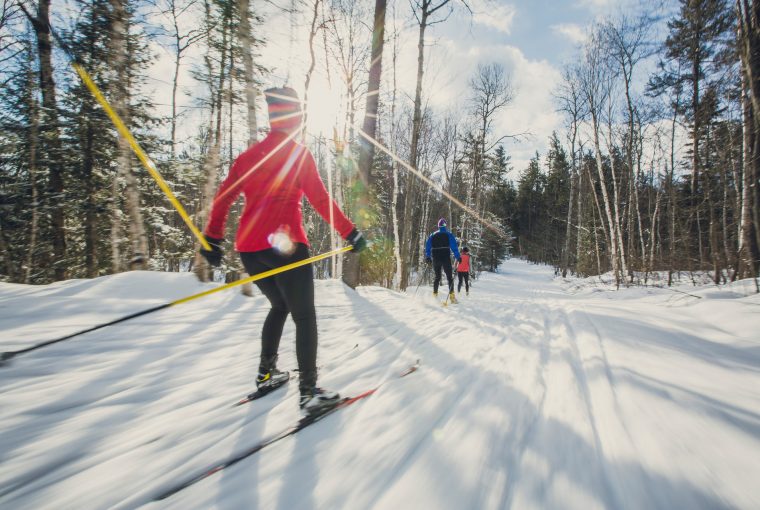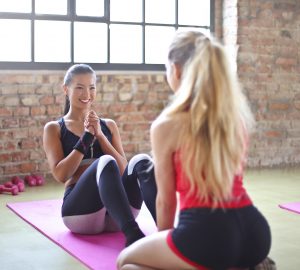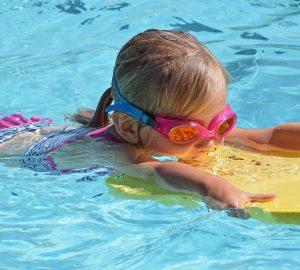If you’re looking for a high-caliber cardio workout to burn calories and build muscle, a great way to get it is with cross-country skiing.
This season, take some time off your board or alpine skis and hit the trails Nordic style for a full-body toning workout. Even if you’re new to flat-land skiing, many ski resorts offer lessons where you can pick up the technique basics and hit closeby trails. U.S. Cross-Country Ski Team member and Olympian Kris Freeman, who represented the United States at the 2010 Winter Olympics and the 2014 Winter Olympics, tells us how to get the most from your time on the trails.
You’ll be sore the next few days, but trust us. It’s worth it—for the health boost and the fun. Here’s how to get started:
Get the Gear You Need
Aside from warm clothing designed for insulation and breathability (that’s a given) you’ll need skis, boots, and poles to propel you forward. All cross-country style skis have bindings that allow the heel to move freely while the ball of the foot is fixed to the ski, but the two different skiing styles—ski touring and skate skiing—require slightly different skis and boots. Invest in your own if you’ll be going out often, or rent from any ski area with cross-country trails. Either way, though, it’s good to know exactly what you need.
For ski touring:
Because you’ll glide longer distances (spending more time in your boots) while ski touring in the backcountry, put comfort first. Get a boot with a snug fit, but with enough room for your preferred socks (i.e. more room for thicker cushioning, less for thin socks). When you lace up your boots, flex your foot fully. If your toes just touch the tip of the boot, the fit is right.
As for skis, go for longer and thinner skis for speed and efficiency. But if you’re heading into deeper snow, you’ll want a shorter and wider ski for maneuverability and flotation to keep you from sinking in. In general, go shorter if you’re less experienced.
For skate skiing:
Skate skiing (literally, a skating motion) is meant for quick outings or races. Comfort is less important than efficiency here. Boots should be the exact size of your foot while wearing your chosen socks. They’ll have more ankle support, and you should have contact with the boot at every point of your foot.
For even greater control while skiing, some go even tighter. Avoid loose skate boots altogether. Skate skis will be shorter (by roughly 10 cm) and lighter than touring skis so you can more easily pick them up off the ground. But they should still be long enough to provide stability and glide. Narrower skis will be faster, and with skate skiing, speed is the goal.
Prep Your Body
To get the most out of cross-country skiing, it’s important to go in well-conditioned. “Cross country skiing uses just about every muscle in your body,” says Freeman. “It’s one of the most demanding cardio sports in the world.”
So before the snow falls, start training in any basic cardio activity, like biking, kayaking, or running. Then, once you feel good, toss in a few intervals, going hard—for 10, then 20, then 30 seconds—with two-minute breaks between sets. You’ll also want to hit the gym to develop a few key muscle groups. Strong shoulders and triceps are essential for using the poles to propel you forward, though you don’t want to be too bulky. Do a few shoulder and tricep exercises with free weights, focusing on high reps to build muscle endurance along with strength.
Your core, though, is where the power is. Freeman notes that most of the propulsion comes from the abs and lower back, so strengthening those will make you a better skier.
Max Your Cross-Country Workout
Freeman has two methods for ideal Nordic ski workouts. As a newcomer, it’s best to find proper form and discover your flow with long, slow, easy distance skiing. Here, your focus is rhythm more than speed and power. It’s about getting as much as you can from every muscle at once, rather than taxing just the legs or triceps and shoulders. “When you’re doing it right, it’s a very coordinated, beautiful motion,” notes Freeman. “Everything has to be powerful and relaxed at the same time.”
The second workout style, which ups the ante by adding more intense intervals, comes into play after you’re comfortable with your rhythm. Freeman suggests doing five sets of six-minute intervals, going hard at more than 90% intensity, followed by a six-minute rest between sets. Freeman can cover about a mile and a half during the six-minute interval, but as a newcomer, aim to cover ¾ of a mile to a mile, maintaining 90% intensity throughout.

Ski Here
You’re in luck. In Freeman’s estimation, you’ll find many of the top cross-country trails in the world right here in the U.S.
Waterville Valley, New Hampshire
Freeman’s favorite ski area is Waterville Valley, New Hampshire, and he says the best loop is a trail called Cascade Brook, which starts with a hard 20-minute climb up a steep slope. At the top, it levels off before dropping back down over a series of switchbacks along an old stream bed. “I do that trail over and over again for hours,” says Freeman.
For those who like going fast, Freeman calls Soldier Hollow in Midway, Utah—where he and other Nordic skiers competed in the 2002 Winter Olympics—one of the best racing venues in the country. Ski easy trails, or test your mettle on the Olympic courses.
The U.S. Cross-Country Ski Team named Methow Valley in Washington one of their top-choice ski areas in the country, and it’s no mystery why. One of the largest cross-country ski areas on the continent, the valley holds more than 120 miles of trails winding through peaceful forest in the Cascade Mountains.




